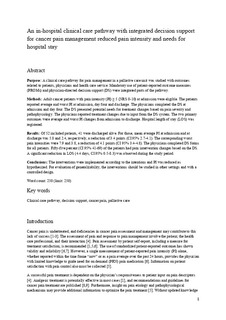| dc.contributor.author | Løhre, Erik Torbjørn | |
| dc.contributor.author | Thronæs, Morten | |
| dc.contributor.author | Brunelli, Cinzia | |
| dc.contributor.author | Kaasa, Stein | |
| dc.contributor.author | Klepstad, Pål | |
| dc.date.accessioned | 2020-01-23T08:48:49Z | |
| dc.date.available | 2020-01-23T08:48:49Z | |
| dc.date.created | 2019-06-13T13:43:45Z | |
| dc.date.issued | 2019 | |
| dc.identifier.citation | Supportive Care in Cancer. 2019, 1-12. | nb_NO |
| dc.identifier.issn | 0941-4355 | |
| dc.identifier.uri | http://hdl.handle.net/11250/2637576 | |
| dc.description.abstract | Purpose
A clinical care pathway for pain management in a palliative care unit was studied with outcomes related to patients, physicians, and health care service. Mandatory use of patient-reported outcome measures (PROMs) and physician-directed decision support (DS) were integrated parts of the pathway.
Methods
Adult cancer patients with pain intensity (PI) ≥ 5 (NRS 0–10) at admission were eligible. The patients reported average and worst PI at admission, day four, and discharge. The physicians completed the DS at admission and day four. The DS presented potential needs for treatment changes based on pain severity and pathophysiology. The physicians reported treatment changes due to input from the DS system. The two primary outcomes were average and worst PI changes from admission to discharge. Hospital length of stay (LOS) was registered.
Results
Of 52 included patients, 41 were discharged alive. For those, the mean average PI at admission and at discharge was 5.8 and 2.4, respectively, a reduction of 3.4 points (CI 95% 2.7–4.1). The corresponding worst pain intensities were 7.9 and 3.8, a reduction of 4.1 points (CI 95% 3.4–4.8). The physicians completed DS forms for all patients. Fifty-five percent (CI 95% 41–69) of the patients had pain intervention changes based on the DS. A significant reduction in LOS (4.4 days, CI 95% 0.5–8.3) was observed during the study period.
Conclusions
The interventions were implemented according to the intentions and PI was reduced as hypothesized. For evaluation of generalizability, the interventions should be studied in other settings and with a controlled design. | nb_NO |
| dc.language.iso | eng | nb_NO |
| dc.publisher | Springer Verlag | nb_NO |
| dc.title | An in-hospital clinical care pathway with integrated decision support for cancer pain management reduced pain intensity and needs for hospital stay | nb_NO |
| dc.type | Journal article | nb_NO |
| dc.type | Peer reviewed | nb_NO |
| dc.description.version | acceptedVersion | nb_NO |
| dc.source.pagenumber | 1-12 | nb_NO |
| dc.source.journal | Supportive Care in Cancer | nb_NO |
| dc.identifier.doi | 10.1007/s00520-019-04836-8 | |
| dc.identifier.cristin | 1704674 | |
| dc.description.localcode | This is a post-peer-review, pre-copyedit version of an article. Locked until 23.5.2020 due to copyright restrictions. The final authenticated version is available online at: https://doi.org/10.1007/s00520-019-04836-8 | nb_NO |
| cristin.unitcode | 194,65,15,0 | |
| cristin.unitcode | 1920,12,0,0 | |
| cristin.unitcode | 194,65,25,0 | |
| cristin.unitcode | 1920,28,0,0 | |
| cristin.unitname | Institutt for klinisk og molekylær medisin | |
| cristin.unitname | Kreftklinikken | |
| cristin.unitname | Institutt for sirkulasjon og bildediagnostikk | |
| cristin.unitname | Klinikk for anestesi og intensivmedisin | |
| cristin.ispublished | true | |
| cristin.fulltext | postprint | |
| cristin.qualitycode | 1 | |
